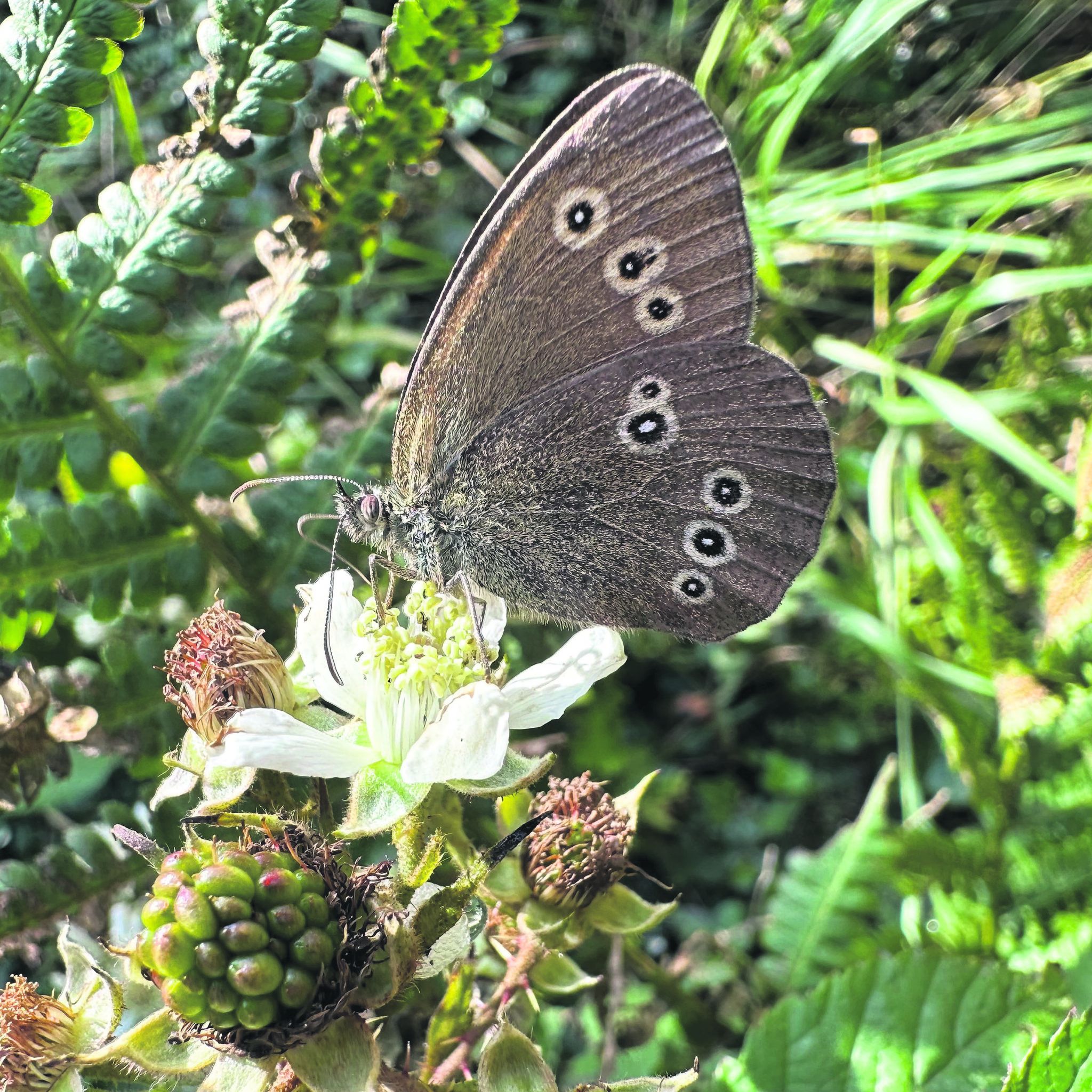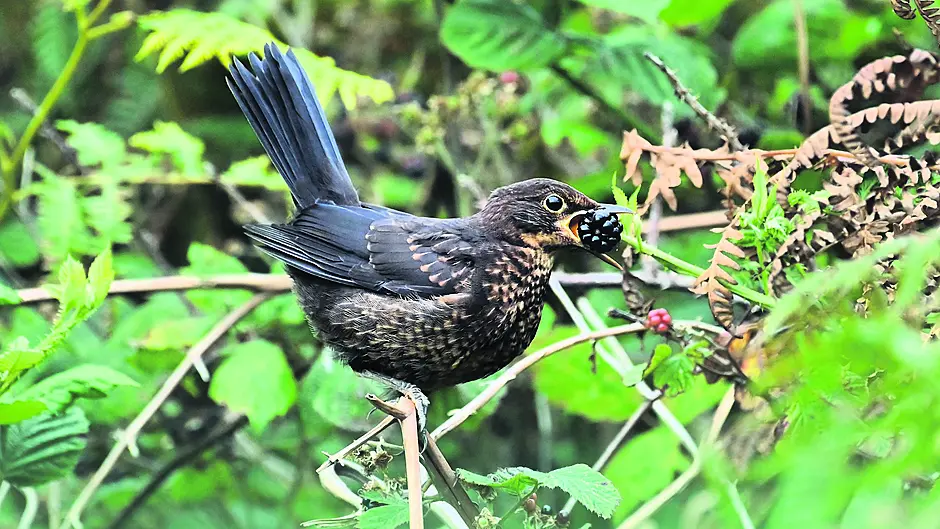BY ANN HAIGH
NOTHING quite signals the end of summer and the start of autumn like the appearance of blackberries in our hedgerows. It seems to me that 2023 has not been as good a year for blackberries as 2022, but they have been plentiful nonetheless.
Every year a bout of ‘blackberry fever’ strikes our family and we tour our quiet roadside verges filling our bowls with juicy goodness. The aroma you get when putting your face over a bowl of freshly picked blackberries and taking a deep sniff is simply wonderful. Our sons return home happily from walks with purple stained fingers and mouths. We then smirk smugly to ourselves as we pass the plastic packaged blackberries for sale in the supermarket. Pay for blackberries? Not us, thank you.
These delicious blackberries have a value to us, for snacks, smoothies, jam and crumbles but what value do blackberries have to wildlife?
A resilient plant
Our native blackberry plant is officially called Rubus fruticosus and can grow in almost every environment. The blackberry plant is also known as the bramble and its pattern of growth forms dense thorny, prickly briars which are designed to make it difficult for grazing herbivores, and coincidentally gardeners, to tackle.
What we consider as the blackberry or bramble plant is actually hundreds of closely related microspecies but we group them as one plant. It is both resilient and versatile and can reproduce sexually (via pollination), asexually without pollination and by sending out runners. Bramble thrives in acidic and nitrogen-rich soils and is commonly found in woods, hedges, and scrubland.
Pollinators
Bramble starts to bloom from late spring to early summer, producing pretty white and pink flowers. Bees, butterflies, and hoverflies visit bramble flowers for pollen and nectar and the plant is an important staple for these pollinators. These pretty flowers produce large amounts of both pollen and nectar, which is readily available to insects with either short or long tongues due to the open shape of the flower. Bramble also has a relatively long flowering period, so it sustains pollinators all summer long. Studies in the UK have proven the value of bramble to pollinators and discovered that from late May to early August, over the sites studied, an average of 31% of the pollen collected by honeybees was from bramble.
 This species of
This species ofsolitary bee, the northern colletes bee, was seen feeding on bramble flowers in Toe Head. This bee is a priority species in the All-Ireland Pollinator plan
A great foodplant
The Biological Records Centre in the UK hosts a Database of Insects and their Food Plants and lists that 150 invertebrate species feed on bramble. These invertebrates include the caterpillars of many moth species which feed on the leaves of bramble. An example of two moth caterpillars that feed on bramble are those of the delightfully named peach blossom and buff arches moths. We have been monitoring the moths in our local area and have discovered many individuals of these two species. This is not surprising since we have many brambles, but positive and encouraging nonetheless. It makes me even more inclined to put that garden clearing off for another day. As we have been picking, we have also seen both shieldbugs and butterflies feeding on the berries, using their straw-like feeding tube, known as a proboscis, to lap up the sugary berry juice.
 Ringlet butterfly seen visiting a bramble flower for nectar in Skibbereen. (Photo: Ann Haigh)
Ringlet butterfly seen visiting a bramble flower for nectar in Skibbereen. (Photo: Ann Haigh)
Patterns on the leaves
One challenge I have for you is to have a close look at blackberry leaves. Have you ever noticed strange squiggly patterns or blotches on them? These patterns or blotches are usually the tunnels of the tiny larval stages of a fly, a sawfly, or various moth species. It is amazing how these miniscule creatures can live inside the leaf, feeding and developing until they eventually break through and emerge from the leaf and become their adult form.
Wildlife benefits
Deer can feed on brambles and the berries are eaten by several other mammals such as foxes and badgers, and by birds such as blackbirds, thrushes, and finches. These animals, in return, help to disperse the blackberry seeds as they pass through their digestive systems.
Bramble briars also provide habitat and give shelter and protection to birds, small mammals such as wood mice, voles, shrews, and many other creatures. Hedgehogs in particular like to hibernate under the briars in nests made up of dead leaves. Some birds such as the wren and blackcap will avail of the natural protection that the bramble thorns provide and build their nests within the bramble bushes.
Enjoy the harvest
Bearing all this in mind, it is obvious that brambles are a vital natural resource for wildlife and therefore it is important that we do not strip and remove all the berries. However, practically, the bramble does a great job of ensuring it is a successful plant by growing and fruiting prolifically and sensible harvesting does little harm. Providing that overly wet weather does not set in, you probably have a week or two left for blackberry
picking.
 Speckled wood butterfly seen here in Castlehaven drinking the juice of a blackberry. (Photo: Ann Haigh)
Speckled wood butterfly seen here in Castlehaven drinking the juice of a blackberry. (Photo: Ann Haigh)
Wet conditions can cause the berries to go mouldy and they eventually become overripe and go to seed. This could be the sensible reason behind the superstition that blackberries should not be picked after Michaelmas, September 29th.
This feast day is a traditional celebration of Archangel Michael casting the devil out of heaven. The story goes that when the devil fell he landed in a patch of brambles. Blackberries, therefore, earned his loathing and the superstition is that he put a curse on the plant, making the berries unpalatable after September 29th. This aside, we will continue to pick them while we can and enjoy sharing nature’s bounty with our local
wildlife.
Ann Haigh MVB MSc MRCVS is a Skibbereen resident, a mum of two, and a veterinarian with a master’s degree in wildlife and conservation and she is passionate about biodiversity and
nature.







